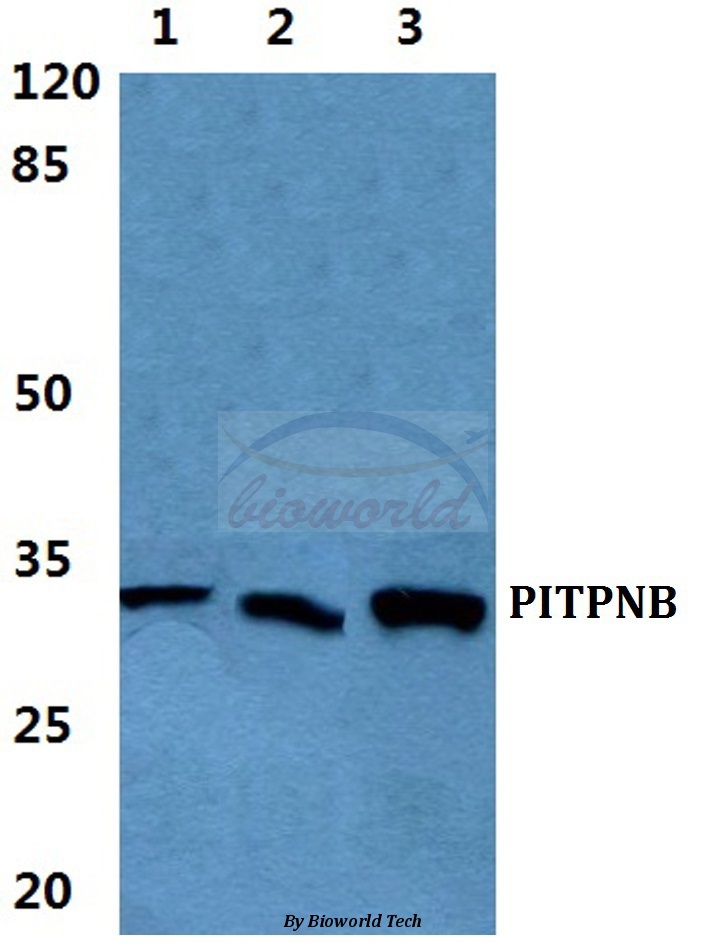Product Name :
PITPNB polyclonal antibody Background :
The lipid binding proteins known as phosphatidylinositol transfer proteins (PITP) facilitate the formation of phosphatidylinositol derived second messenger molecules, which are related to the phospholipase C and phosphoinositide 3-kinase pathways. PITP are ubiquitously expressed proteins that transfer phosphatidylinositol (PI) and phosphatidylcholine (PC) between membranes enriched in PI or PC to membranes that are deficient in PI or PC. PITP mobilizes PI from the endoplasmic recticulum and regulates the release of PI from stored vesicles in the Golgi network. In mammalian cells, three smaller forms of soluble PITP are present, designated PITPα, PITPβ and retinal degeneration B (rdgB) beta. PITPβ is a 271 amino acid protein that is widely expressed in various tissues. Though required for Golgi targeting, constitutive phosphorylation of Ser-262 has no effect on phospholipid transfer activity. There are two isoforms of PITPβ that are produced as a result of alternative splicing events. Product :
Rabbit IgG, 1mg/ml in PBS with 0.02% sodium azide, 50% glycerol, pH7.2 Storage&Stability :
Store at 4°C short term. Aliquot and store at -20°C long term. Avoid freeze-thaw cycles. Specificity :
PITPNB polyclonal antibody detects endogenous levels of PITPNB protein. Immunogen :
Synthetic peptide, corresponding to amino acids 226-271 of Human PITPNB. Conjugate :
Unconjugated Modification :
Unmodification
PITPNB polyclonal antibody Background :
The lipid binding proteins known as phosphatidylinositol transfer proteins (PITP) facilitate the formation of phosphatidylinositol derived second messenger molecules, which are related to the phospholipase C and phosphoinositide 3-kinase pathways. PITP are ubiquitously expressed proteins that transfer phosphatidylinositol (PI) and phosphatidylcholine (PC) between membranes enriched in PI or PC to membranes that are deficient in PI or PC. PITP mobilizes PI from the endoplasmic recticulum and regulates the release of PI from stored vesicles in the Golgi network. In mammalian cells, three smaller forms of soluble PITP are present, designated PITPα, PITPβ and retinal degeneration B (rdgB) beta. PITPβ is a 271 amino acid protein that is widely expressed in various tissues. Though required for Golgi targeting, constitutive phosphorylation of Ser-262 has no effect on phospholipid transfer activity. There are two isoforms of PITPβ that are produced as a result of alternative splicing events. Product :
Rabbit IgG, 1mg/ml in PBS with 0.02% sodium azide, 50% glycerol, pH7.2 Storage&Stability :
Store at 4°C short term. Aliquot and store at -20°C long term. Avoid freeze-thaw cycles. Specificity :
PITPNB polyclonal antibody detects endogenous levels of PITPNB protein. Immunogen :
Synthetic peptide, corresponding to amino acids 226-271 of Human PITPNB. Conjugate :
Unconjugated Modification :
Unmodification
-
 Western blot (WB) analysis of PITPNB polyclonal antibody at 1:500 dilution Lane1:HEK293T cell lysate Lane2:Raw264.7 cell lysate Lane3:Rat heart tissue lysate
Western blot (WB) analysis of PITPNB polyclonal antibody at 1:500 dilution Lane1:HEK293T cell lysate Lane2:Raw264.7 cell lysate Lane3:Rat heart tissue lysate
Bioworld Biotech only provide peptides for our antibodies and do not provide additional peptide customization services.
Price/Size :
USD 368/1mg/vial
Tips:
For phospho antibody, we provide phospho peptide(0.5mg) and non-phospho peptide(0.5mg).Describe :
Blocking peptides are peptides that bind specifically to the target antibody and block antibody binding. These peptide usually contains the epitope recognized by the antibody. Antibodies bound to the blocking peptide no longer bind to the epitope on the target protein. This mechanism is useful when non-specific binding is an issue, for example, in Western blotting (WB) and Immunohistochemistry (IHC). By comparing the staining from the blocked antibody versus the antibody alone, one can see which staining is specific; Specific binding will be absent from the western blot or IHC performed with the neutralized antibody.Formula:
Synthetic peptide was lyophilized with 100% acetonitrile and is supplied as a powder. Reconstitute with 0.1 ml DI water for a final concentration of 10 mg/ml.The purity is >90%,tested by HPLC and MS.
Storage:
The freeze-dried powder is more stable. For short time at 2-8°C. For long term storage store at -20°C.
Note :
This product is for research use only (RUO only). Not for use in diagnostic or therapeutic procedures.
 PITPNB polyclonal antibody
PITPNB polyclonal antibody  Datasheet
Datasheet COA
COA MSDS
MSDS SHIP
SHIP